The favorite of many summer residents is the White Angel cucumber variety with an unusual appearance and pleasant taste.
White Angel - a hybrid of a mid-season cucumber, was bred in 2002 by experts from the Moscow agricultural firm "Gavrish", became popular because of its unusual color. But is this only its peculiarity?
Why did the hybrid become popular for cultivation in large and small farms, in personal and suburban areas? How tasty and can it be? How to grow and what kind of harvest to expect? The answers to all questions about the White Angel are in our article.
The content of the article
Description of cucumbers
White angel suitable for growing in open ground and greenhouse conditions throughout the country... It is unpretentious, but maintaining the parameters recommended by breeders (temperature, humidity, soil composition) is necessary.
From sowing to the first fruits, on average, 44-50 days pass. The hybrid is parthenocarpic, the ovaries are arranged in bundles. It branches strongly and forms powerful whips.
Distinctive features
Non-standard color is a distinctive feature of the hybrid, otherwise it is a common cucumber, suitable for fresh salads and pickles.
Interesting fact. The hostesses say that it is best to add this hybrid to the assortment. It looks spectacular in jars along with traditional green cucumbers and tomatoes.
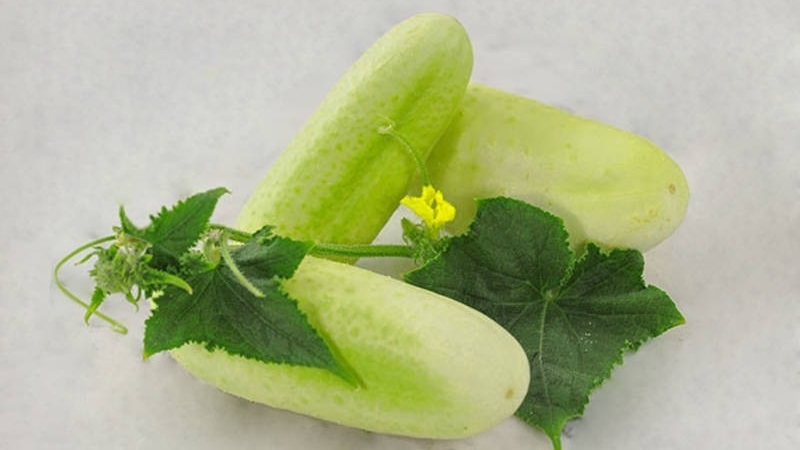
Besides the unusual white color, the fruits of this hybrid are characterized by:
- thin peel;
- small, non-prickly tubercles;
- juiciness and aroma;
- lack of pubescence on the fetus;
- cylindrical shape.
Despite the thin skin, cucumber White Angel perfectly withstands transportation and storage.
Composition and properties
The white angel, like all cucumbers, is 95% water. Contains fiber and vitamins A, B1, B2, C, PP. It is useful for its high mineral content, which makes it popular for diet food. The composition contains potassium, magnesium, zinc, copper, manganese, iron, chlorine, iodine, chromium, phosphorus, sodium, folic acid.
Regular consumption of the vegetable helps to remove toxins and toxins from the body, gently cleanse the intestines, and activate metabolic processes.
White angel is the constant helper of all losing weight: it contains only 15 kcal per 100 g.
Green cucumbers rarely cause allergic reactions, and white in this sense is absolutely safe. The absence of coloring pigment reduces the risk of allergies to zero.
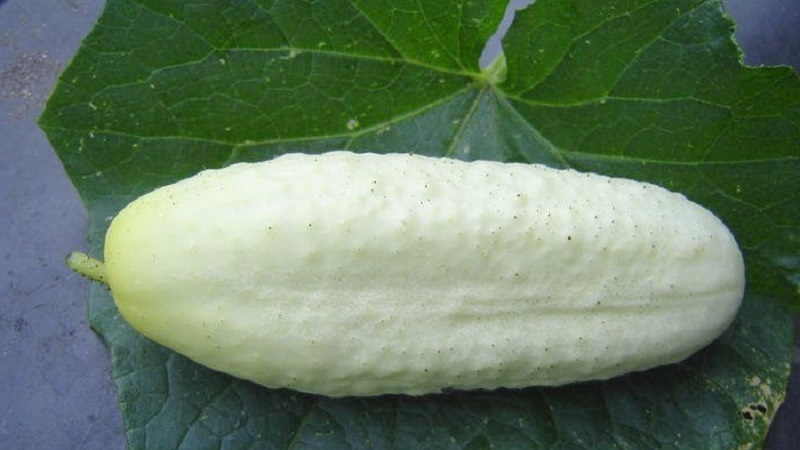
Specifications
The growth of the central whip of the cucumber bush is not limited, the bush independently forms numerous side shoots. The flowering type is mixed, with a predominance of female flowers. It does not need pollination for fruit setting.
The leaves are irregular, dark green in color; 1-2 ovaries are formed in the leaf axils.
Reference. A high-yielding hybrid - up to 4 kg of cucumbers (approximately 20 pieces) can be harvested from one bush.
Ripe fruit 6–8 cm long, with loose juicy pulp... If the cucumber has grown to 10 cm, then its flesh becomes thin, the fruit itself coarsens and loses its taste. White cucumbers outgrow quickly.
The taste of a young white cucumber is sweetish... The bitterness inherent in some varieties of green cucumbers is practically absent. Has a pleasant fresh aroma.
The fruits are harvested after they acquire a light greenish tint.... The more often the harvest is carried out, the higher the percentage of new ovary.
How to grow a hybrid yourself
The White Angel is grown in two standard ways for this culture: seed or seedling.
The hybrid is not picky about conditions, but requires sufficient humidity and heat... It manifests itself best on loamy air-permeable soil.
Reference. The best predecessors for this hybrid are cabbage, peppers, potatoes, and onions.
Planting by seed and seedling method
When planting cucumbers with seeds, it is advisable to soak them in a solution of potassium permanganate for 2–2.5 hours to protect against possible pests.
Features of planting seeds in open ground:
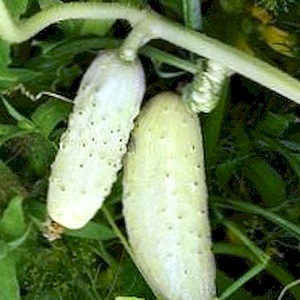 The place is chosen moderately sunny, but warmed up, protected from the wind.
The place is chosen moderately sunny, but warmed up, protected from the wind.- Seeds are sown when the soil temperature reaches + 14-15 ° С.
- The grooves are located at a distance of 20–25 cm from each other.
- The depth of each is 6–8 cm, the distance between the seeds is at least 3 cm.
Features of the seedling method:
- The distance between the rows is 16–20 cm.
- The depth of the holes is 10–12 cm.
- Before planting, a mixture of peat or humus and superphosphate (5–10 g) is added to each well.
- 0.5–1 l of water is poured into the wells, after which a sprout is placed and covered with soil.
When planting seedlings for the White Angel, the "rule of three" applies: The seedlings are at least three weeks old, and at least three leaves must be formed on the stem.
Growing in stages and care
Cultivation of a hybrid White Angel can be conditionally divided into three main periods.
Planting and waiting for the first shoots
Actions: planting in the ground and maintaining the required moisture level. The area with the planted seeds is covered with a film and it is not removed until shoots appear. In the seedling method, it is important to mulch the plants. This will help retain moisture and make it harder for weeds to germinate.
Care of young seedlings
Actions: it is necessary to monitor the moisture content of the soil, to prevent it from drying out. It is important to carry out weed control near the bushes and in the aisles, to inspect the plantings for the appearance of pests, to control them.

Blooming bushes care and harvest
Actions: maintaining the necessary moisture and periodic collection of fruits. Cucumbers should be removed from the lashes, which have grown to a size of 5-7 cm, the overgrown flesh becomes thin and the skin coarsens.
General advice for growing
Caring for the White Angel identical to caring for other varieties familiar to gardeners - watering, weeding and fertilization of the soil are necessary.
Water the plants warm settled water under the root... To freshen the leaves, it is recommended to spray once a week. Watering is carried out in the evening, after sunset. The regularity of soil moisture depends on the degree of drying out of the soil. On hot days every day, in cloudy weather, the amount of watering is reduced.
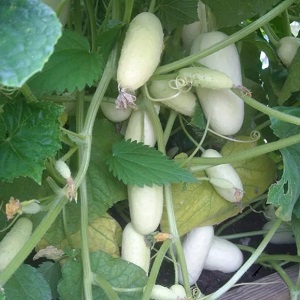 During the growing season to enhance the growth of the bush and to improve the taste, the fruits are fed 2-3 times. For this, organic and mineral fertilizers are used in a complex manner. Well suited "Nitrofoska" and mullein, bird droppings. The solution is prepared in the following proportions:
During the growing season to enhance the growth of the bush and to improve the taste, the fruits are fed 2-3 times. For this, organic and mineral fertilizers are used in a complex manner. Well suited "Nitrofoska" and mullein, bird droppings. The solution is prepared in the following proportions:
- 1 tbsp. l. "Nitrofoski" for 10 liters of water;
- 500 ml of organic matter (infusion of mullein or chicken droppings) per 10 liters of water.
Infusion withstand two hours and use for watering at the root. This amount of solution is enough for two square meters of soil.
Reference. Using "Nitrofoski" for feeding can increase the yield of cucumbers by 15%.
The first time the cucumbers are fertilized when the plants are well rooted and grow.
The second feeding is carried out during the mass beginning of flowering.
Fertilize the third time when the fruits begin to pour and gain weight. Stop feeding two to three weeks before the start of the harvest.
Features of cultivation and possible difficulties
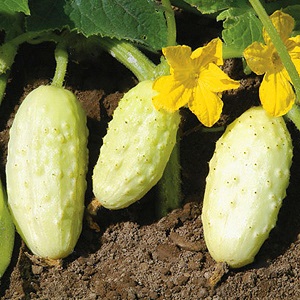 Hybrid White Angel has low resistance to diseases and pests... To protect future plants, the selected area is checked for the presence of harmful insects (in particular, aphid carriers) before planting.
Hybrid White Angel has low resistance to diseases and pests... To protect future plants, the selected area is checked for the presence of harmful insects (in particular, aphid carriers) before planting.
When the leaves form on the bushes it is required to regularly inspect the landings for the appearance of small pests. If detected, processing is carried out immediately, otherwise you can lose the entire crop.
Waterlogging of the soil negatively affects on the bushes and causes rotting of the root system. Moderation of watering is an important step in caring for White Angel cucumbers.
Can't stand hybrid and cold... If the air temperature drops below + 15 ° C, the plants are covered with foil.
Typical diseases and pests
Hybrid such diseases affect:
- Brown spot - appears on leaves and fruits in the form of grayish-olive spots. To get rid of it, greenhouses are fumigated with sulfur dioxide, in an open space they are sprayed with 1% Bordeaux liquid.
- Mosaic virus - leaves become mottled, deformed and curled. All weeds near the bush should be eliminated, their remains deeply plowed, and infected bushes removed.
- Powdery mildew - the plant is covered with a white bloom. If you do not start the fight in time, the bush dries up. At the first sign of illness, plants are treated with fungicides - these can be purchased at a gardening store.
Pests that can cause great harm to the crop - aphids and spider mites.
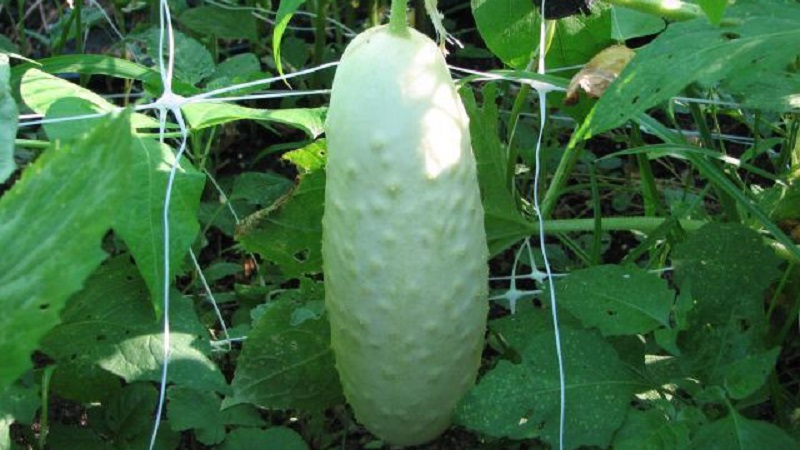
Aphids are easy to recognize by the appearance of small green or black insects on the bushes., wilting leaves, falling flowers.
Reference. Experienced gardeners say: if there are ant colonies on the site, then there are aphids. Planting should be especially carefully checked, especially near anthills.
In the fight with aphids efficient processing strong tobacco infusion with the addition of laundry soap. You can use ammonia (50 g per 10 liters of water) and soap.
The first warning sign of appearance spider mite - on the leaves of cucumbers, a thin dense web of milky color and damage to the marble pattern are found. To get rid of the insect, the bushes are abundantly treated with soapy water and sprayed with Actellik.
Attention! If you find pests during the formation of the ovary, it is better to use safe (non-chemical) processing methods.
Harvesting and application of the crop
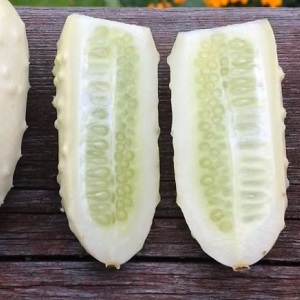 Harvesting begins in July-early August... It is recommended to pick the fruits without waiting for their outgrowth - when they reach a length of 5-7 centimeters. A 10 cm cucumber is already considered overgrown.
Harvesting begins in July-early August... It is recommended to pick the fruits without waiting for their outgrowth - when they reach a length of 5-7 centimeters. A 10 cm cucumber is already considered overgrown.
Ripe fruits are removed daily or every other day, in the evening or morning hours. The correct collection is not to pluck the cucumber from the bush, but carefully cut with pruning shears, leaving the stalk on the stem.
Harvested cucumbers put away in a cool room, protected from direct sunlight and covered with burlap or other lightweight natural fabric.
Keep the harvested crop fresh for two weeksif you use one of these methods:
- Wrap the cucumbers in plastic wrap and leave in a cool place.
- Place the fruits, feet down, in a bowl of cold water (change the water periodically).
- Wash cucumbers, dry and coat each with egg white.
Fresh fruits of the White Angel look original in colorful salads... In color and taste, they go well with tomatoes, bell peppers, dark olives and green cucumbers.
Often mistresses use an unusual cucumber for pickles and pickles.
Reference. The recipe for pickling cucumbers White Angel is standard - the same as for green cucumbers: for a three-liter jar, 100 g of salt, 100 g of sugar, 50 g of vinegar. The versatility of the recipe allows you to create beautiful and original "compositions in jars" from cucumbers of different colors.
Since the taste of the fruits does not differ from other cucumbers, they are used in any other preparations.
Advantages and disadvantages
The white angel has both disadvantages and advantages.
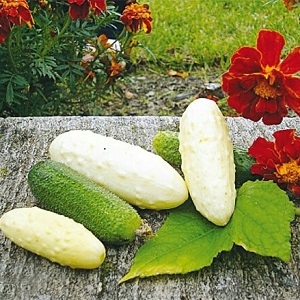 Pros of a hybrid:
Pros of a hybrid:
- excellent taste;
- original type of fruit;
- unpretentiousness to growing conditions;
- the possibility of long-term storage.
Minuses:
- instability to diseases and pests;
- rapid outgrowth of fruits;
- a decrease in the quality of fruits during the second wave of the harvest (tuberosity, thick skin, watery pulp, loss of the correct cylindrical shape).
Cucumber reviews White Angel
Most gardeners and farmers speak positively about the White Angel hybrid.
Julia, Voronezh: “I grew a hybrid for trial. Now I can say with confidence that the White Angel is the best cucumber that I have ever tried and grown. I take off the harvest every day. Do not taste bitter. They look exclusive, but they are rather light green in color. Although, in comparison with other cucumbers, they really look white. Among the shortcomings, I can only note the prickly fruits, it is difficult to pick them with bare hands ".

Larisa, Oryol: “The white angel is only suitable for exotic things - to surprise neighbors and acquaintances. Half of the seeds did not sprout, the ovary was small - as a result, the yield was lower than expected. I did not notice any differences from the usual cucumber, except for the color - the taste and smell are the same ".
Ivan, Tula: “I have been engaged in farming for several years, I tried the White Angel hybrid. Disappointed with the second wave of the harvest: the fruits quickly deformed, they could not be sold. Therefore, I will no longer venture to grow white cucumbers - farmers have different priorities, and the exclusivity of fruits is not included in their list. "
Conclusion
With all the shortcomings, the White Angel is a promising hybrid for growing. It is popular among gardeners and summer residents. To harvest a good harvest, it is enough to follow the basic rules of care and monitor the plantings.
Quality fruits are harvested during the first wave of the harvest and are kept fresh for two weeks. White cucumbers are suitable both for pickling and pickling, and for fresh consumption.